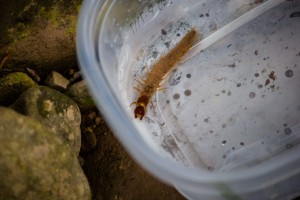Notice of virtual public hearing on 3/9 at 6PM; comments due on 3/11
The WVDEP is once again accepting public comments on a revised rule that analyzes the aquatic life in the stream to assess whether the stream is meeting the state’s water quality standards.
The latest iteration of the procedural rule is being developed by WVDEP in response to SB 687 passed in 2017. Its purpose is to define the aquatic life component in the narrative water quality standards and the threshold at which the standard is being met or not.
The narrative water quality standards state that a stream must be able to support aquatic life. This narrative standard has been used to hold industry accountable for polluting a stream to the point where it no longer supports a healthy population of aquatic organisms. The aquatic organisms used to measure stream health are the benthic macroinvertebrates.
WVDEP’s proposed procedural rule describes an approach based on the current method that WVDEP has used for the past 18 years. The agency has yet to adopt EPA’s recommended method. The currently used method, WV Stream Condition Index (WVSCI), scores aquatic life communities on a scale of 0-100. The proposed rule would establish an impairment threshold of 50, an attainment threshold of 72, and values between 50 and 72 must undergo additional analysis. View a flowchart of how the assessment process works.
This revised method raises several concerns:
>> The impairment value of 50 and 61 are not based on any statistical information or scientific data.
>> The streams receiving values between 50 and 72 must undergo additional analysis, during which time they are neither listed as impaired nor considered healthy.
>> The proposed rule does not fulfill WVDEP’s duties under the Clean Water Act and allows DEP to delay listing streams that fall within 50 and 72 until additional analysis is performed.
>> The current method, WVSCI, used to calculate whether a stream supports aquatic life is outdated and should be updated to the more accurate, EPA recommended method, Genus Level Assessment of Most Probable Stream Status (GLIMPSS).
Let WVDEP know you want them to use a more precise method to assess stream health! Submit your comments by March 11 and join WVDEP’s virtual public hearing on the rule March 9 at 6:00pm by following these instructions.
Submit Comments to WVDEP here.
West Virginia Rivers Coalition
3501 MacCorkle Ave SE #129
Charleston, West Virginia 25304
wvrivers@wvrivers.org


{ 1 comment… read it below or add one }
Comment on WVDEP’s Biological Assessment Rule
From the West Virginia Rivers Coalition, Charleston, WV, March 9, 2021
Stream critters need your voice! WVDEP is accepting comments on a rule that weakens the analysis of the aquatic life found in a stream to assess whether the stream is meeting the state’s water quality standards.
This new method was developed by WVDEP in response to legislation the WV Coal Association lobbied to pass, including Senate Bill 687 in 2017.
Our water quality standards say that a stream must be able to support aquatic life. When this standard is applied, an assessment of the benthic macro invertebrates (aka stream bugs) is conducted. But the question is: How much life can be killed before action is taken to reduce pollution?
To be able to address pollution before it kills off stream life, the most precise measurement to assess stream life should be used. The WVDEP is proposing to use an outdated method. Since 2010, the EPA has recommended WVDEP adopt a more scientifically precise system called GLIMPSS. EPA has also opposed WVDEP putting certain streams in a “grey zone” category where compliance with water quality standards is not determined. This grey zone keeps streams from receiving the help they need to meet our water quality standards.
You can submit comments on the proposed rule through April 20. (This extended deadline was set so that a 45 day Comment Period would satisfy the US EPA requirement).
https://wvrivers.salsalabs.org/wvdepbiologicalassessmentrule/index.html?eType=EmailBlastContent&eId=7ee969bf-eadf-4db5-ab35-c89e0e5a81e6